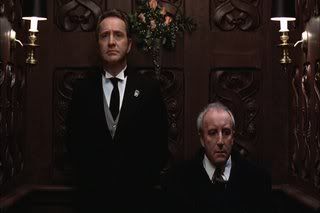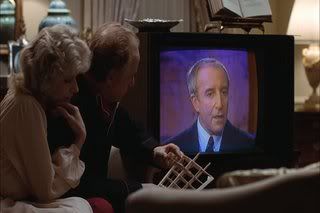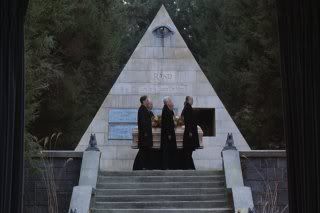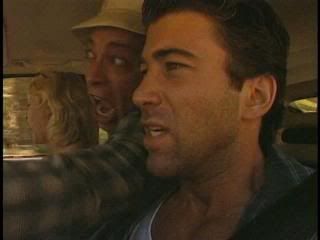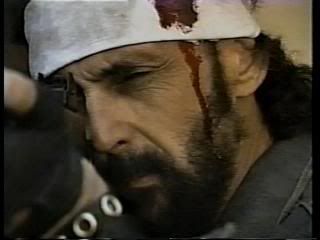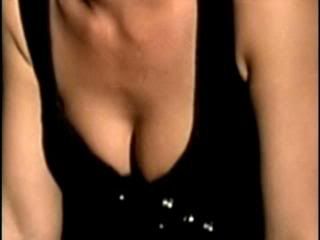There's a lesson to be learned from Hellbound: Book Of The Dead, a well made but slow-moving horror effort from director Steve Sessions (Dead Clowns). If you're going to make a moody, deliberately paced horror film that relies on suspense rather than fast paced thrills and gore, it's probably best not to title your film in a way that recalls both The Evil Dead and Hellraiser. The film's alternate title, Cadaver Bay, has its own issues but at least doesn't set expectations that the film has no possibility of reaching.
Which is not to say that Hellbound is a bad movie. In fact, it looks terrific for a low budget film with strong camerawork and cinematography from start to finish. Sessions obviously has a strong vision of how he wanted this film to look, and used inventive camera angles and filtered lighting to achieve the proper atmosphere throughout. It's the muddled, stretched story that really lets the film down, stretching a slight plot beyond it's breaking point to fill out the 80 minute run-time.
Diane (Elizabeth North) is in mourning following the unexpected hubcap-related death of her sister. Her boyfriend Lane (Jeff Dylan Graham) has been looking after her during her recovery, but worries that things may take a turn for the worse after Diane receives a call about a book that her father, a practicing witch, had been looking for before his death. This book, once matched with it's pair, has to power to bring the dead back to life. Things go haywire once Diane kills the bookseller, recognizing that if the book is sold it will lose its power, and after a failed attempt to bring him back to life, Lane is tasked with disposing of the body (via circular saw and encasing the bits in concrete). Unfortunately, as he finishes he discovers that the corpse's hand has returned to, um, life and running around getting into all sorts of shenanigans. Diane, convinced that the spell works, tries to bring another corpse to life with predictably tragic consequences.
Structured like a thirty minute episode of Tales From The Crypt, Hellbound suffers greatly from a dreadfully slow first hour packed with exposition delivered stiltedly and seemingly endless shots of character's looking forlorn. A subplot regarding the often-naked neighbour goes absolutely nowhere, and by the time things start to pick up slightly after the hand starts running around, most viewers would have already abandoned ship.
The acting certainly isn't anything special, but I hesitate to put the blame on the two main performers. The dialogue often seems robotic and unnatural, often abandoning natural sounding contractions, which make the performances seem amateurish. This isn't helped by the choice to deliver the lines almost totally without emotion, even in situations where the average person would be hysterical. Jeff Dylan Graham has fashioned an impressive b-movie career for himself, but shows little to distinguish himself here. Elizabeth North is mostly catatonic throughout, making the pair a bit painful to spend a majority of the running time with.
On a brighter note, the special effects (by Jonathan Fuller) throughout the film are quite good. The effect of the crawling hand is achieved brilliantly, with some minor computer effects and deft editing creating a strong illusion. While the film uses gore sparingly, when it kicks in (as in the scene where a character is assaulted with a corkscrew) it's appropriately messy. When the corpse is finally revealed near the film's end the make-up is quite impressive, and features quite an excessive amount of maggots for those who enjoy that sort of thing.
As with many of the film's in this collection, the image quality of Hellbound suffers from some excessive pixelation, likely as a result of fitting as many of these films onto the DVD as possible. It's always watchable, and quite cinematic despite being shot on digital video, but there are a few glitches in the video and audio. The soundtrack is sometimes excessive, particularly since it's required to underscore a number of slow scenes of suspense. It sounds quite good, but doesn't always appropriately serve the visuals.

An atmospheric, stylish horror movie that suffers from a lack of plot and uninteresting characters, Hellbound: Book Of The Dead shows a lot of promise but proves to be tedious to get through. Still, with better material i'm confident that director Steve Sessions could craft a stronger, more entertaining horror film.







